Home Decor
How to Style Your Home Like an Interior Decor Expert!
Create a stunning home interior with expert tips that will transform your space—discover the secrets to achieving a beautifully styled environment!
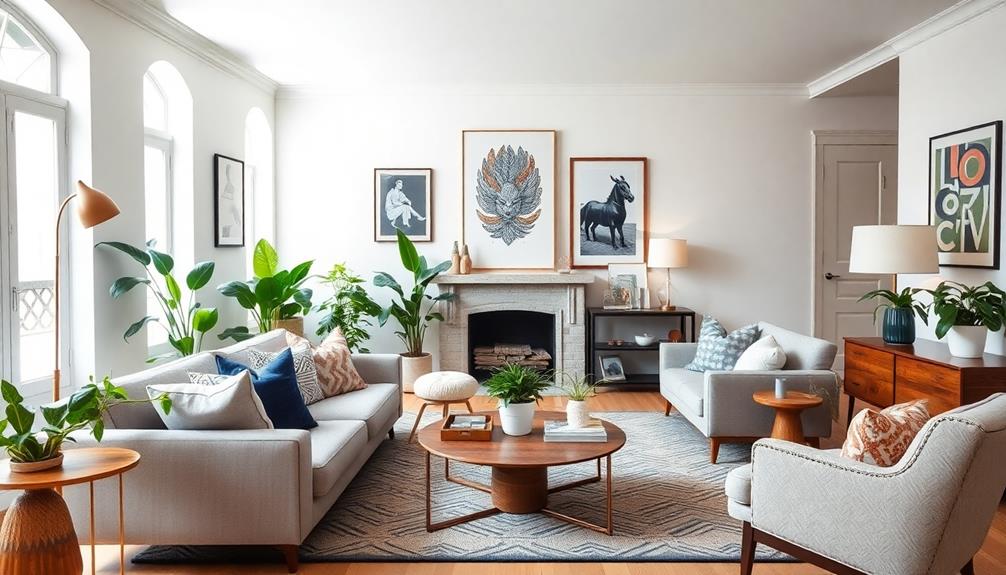
To style your home like an interior decor expert, start by establishing a budget and creating a mood board filled with your favorite colors and textures. Select an inspirational object to unify your theme and plan a room layout that promotes flow. Choose high-quality, versatile furniture pieces and decide on a cohesive color scheme. Layer different textures to add depth and comfort, and don't forget to personalize your space with unique decor. Finally, optimize lighting to enhance the ambiance. These foundational steps set the stage for a beautifully styled home, and there's so much more detail to explore! Expert tips for interior decor also include paying attention to the scale and proportion of your furniture and decor, as well as incorporating elements of nature, such as plants or natural materials, to bring life and balance to a room. Additionally, considering the function of each space and incorporating storage solutions can help maximize both the aesthetic and practical aspects of your home decor. By following these expert tips for interior decor, you can create a stylish and personalized space that reflects your unique taste and personality. By incorporating these tips and tricks, you can achieve a balanced interior decor that is both visually appealing and functional. Consider adding accent pieces, such as throw pillows, rugs, and artwork, to tie the room together and add a pop of color or pattern. Pay attention to the scale and placement of these elements to ensure they enhance the overall aesthetic without overwhelming the space. Finally, don’t be afraid to experiment and make adjustments as needed to create a space that truly feels like home.
Key Takeaways
- Establish a clear design budget, prioritizing must-haves and including a cushion for unexpected expenses to guide your spending.
- Create a mood board to visualize your design inspiration, utilizing colors, textures, and materials that reflect your desired aesthetic.
- Select a unique inspirational object to anchor your design theme, guiding color palettes and ensuring cohesiveness with existing decor.
- Optimize room layout for traffic flow and furniture functionality, using scaled drawings or apps for effective planning.
- Incorporate layered lighting techniques, including ambient and task lighting, to enhance the ambiance and highlight key design features.
Establish Your Design Budget
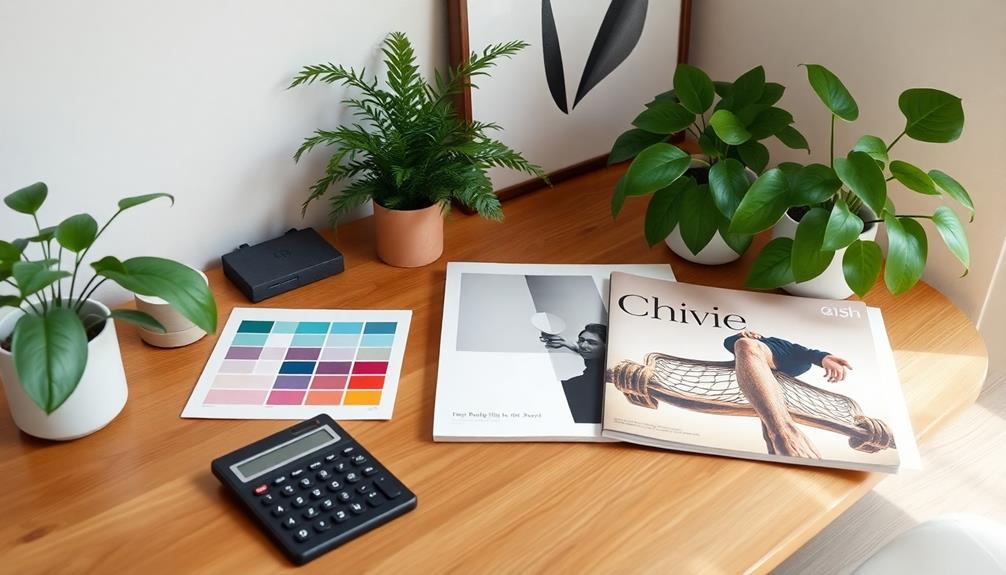
Setting a clear design budget is essential for any home styling project. You need to prioritize expenditures into must-haves, nice-to-haves, and not priorities. This method helps you effectively manage remodeling costs while guaranteeing your home decor reflects your style.
Additionally, consider exploring modern Indonesian housing trends for inspiration on eco-friendly materials and smart designs. Start by creating a detailed spreadsheet that outlines all project elements and their costs. Don't forget to include a cushion of 10%-20% for unexpected expenses. This will help you avoid financial surprises along the way.
To make informed decisions about your budget allocation, obtain at least three contractor bids. This will allow you to compare costs and assess quality, guaranteeing you're getting the best deal.
Before purchasing furniture pieces, prepare accurate measurements and layout drawings to ensure they'll fit well within your space. This not only maximizes your design impact but also keeps you within your budget.
Lastly, remember that an effective budget accounts for ongoing maintenance costs and potential future upgrades. By planning ahead, you guarantee the longevity of your modern design choices while achieving a home that's both stylish and functional.
Create a Mood Board

Once you've established your design budget, the next step is to create a mood board that captures your vision for the space. Start by gathering design inspiration from magazines, Pinterest, and even nature. This will help you identify the overall feel you want. Choose a springboard object that resonates with your personal style; it'll guide your color schemes and design choices.
To create a visual representation of your ideas, use a combination of images, fabric swatches, paint samples, and flooring options. Guarantee all elements work harmoniously together by organizing your mood board into groups based on similar colors and textures. This approach allows you to see how different components interact in your final design.
Here's a simple table to help you visualize your mood board elements:
| Color Scheme | Texture | Design Inspiration |
|---|---|---|
| Soft Neutrals | Linen & Wood | Nature-Inspired |
| Bold Jewel Tones | Velvet & Metal | Modern Art |
| Earthy Tones | Stone & Canvas | Rustic Charm |
Regularly revisit and revise your mood board as your ideas evolve. It's a dynamic tool that refines your vision before making any purchasing decisions.
Select an Inspirational Object

Selecting an inspirational object is essential to establishing your design theme and can greatly influence the overall aesthetic of your space. Choose a unique piece of art, a vintage find, or a statement furniture item that resonates with your personal style. For instance, an Indonesian decorative pillow with vibrant colors and intricate patterns can serve as a vibrant focal point in your living area. This object will serve as the foundation for your design scheme.
Ensure that your chosen inspirational object complements the overall aesthetic while integrating well with existing decor to create a cohesive look. Use it to guide your color palette and texture choices, drawing on its hues and materials to cultivate a harmonious environment.
Pay attention to the scale and placement of the object within the room. It should enhance the flow and accessibility of the space, drawing attention without overwhelming the area.
Incorporate additional elements that reflect the essence of your inspirational object, such as matching colors or similar materials. This will reinforce its influence throughout your design scheme, creating a unified and inviting atmosphere.
Plan Your Room Layout

To create a functional and inviting space, start by measuring your room accurately, including all doors and windows.
With these dimensions in hand, you can design a layout that promotes smooth traffic flow and accommodates your furniture effectively.
Consider incorporating space maximization and organization hacks to make the most of your area.
Measure and Design Layout
Getting started with your room layout requires careful planning and measurement. Begin by taking accurate measurements of your space, guaranteeing you know the dimensions of the room and any furniture pieces you plan to use. Creating a scaled drawing with graph paper or a floor planner app can help you visualize the layout effectively.
Consider the intended function of your room and prioritize accessibility. Make sure pathways are clear, allowing for ideal traffic flow. Here's a simple table to help you organize your layout planning:
| Element | Description | Notes |
|---|---|---|
| Measurements | Room dimensions | Accurate is key |
| Furniture Pieces | Versatile, functional pieces | Maximize space |
| Aesthetic | Style and color cohesion | Guarantee harmony |
Once you've mapped everything out, establish a detailed spreadsheet of costs, adding a cushion of 10%-20% for unexpected expenses. Don't forget to get at least three contractor bids to compare costs and gain insights into ideal layout strategies. This preparation will enhance both the functionality and aesthetic of your space.
Traffic Flow Considerations
Establishing effective traffic flow is essential for creating a functional and inviting room layout. To start, focus on furniture placement that allows for clear pathways. Aim for at least 24-36 inches of space between pieces to guarantee comfortable movement.
Consider incorporating natural materials like wood and stone, as seen in traditional Indonesian style home decor, to enhance both aesthetics and functionality. Think about the room's purpose; for instance, if it's a living room meant for conversation, arrange seating to foster interaction.
To help visualize your layout, use graph paper or free floor planner apps. This way, you can identify potential congestion areas before moving any furniture. Pay close attention to door swings, windows, and walkways to avoid obstructions that disrupt the flow.
In smaller spaces, consider incorporating multi-functional furniture, like ottomans or side tables, which can enhance versatility while keeping the flow unobstructed.
Choose Foundation Furniture
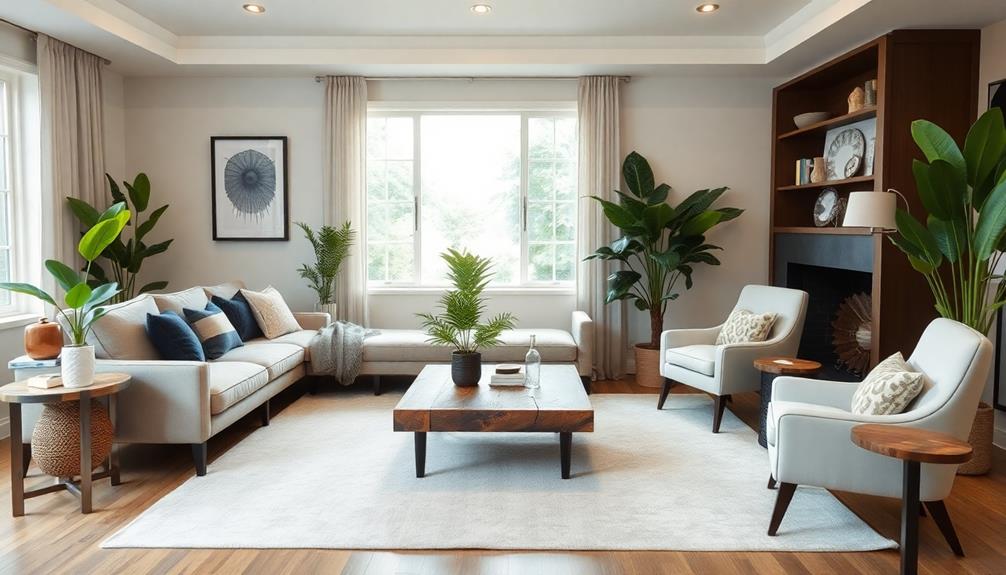
Foundation furniture serves as the backbone of your home's design, providing both structure and style. When choosing these essential pieces, focus on high-quality options that guarantee durability while aligning with your overall design theme. This creates a cohesive aesthetic throughout your space.
Consider versatile furniture that adapts to your needs. For instance, a sofa bed or an extendable dining table can be invaluable in smaller living areas. Pay attention to the dimensions of your foundation furniture; they should fit comfortably within your space, promoting adequate traffic flow and accessibility without making the area feel crowded.
Opt for timeless designs and neutral colors for these foundational pieces. This choice allows you to easily blend with seasonal decor changes and evolving personal styles. Finally, prioritize functionality—selecting furniture that enhances usability is key. Storage ottomans or multi-functional coffee tables can be both practical and stylish.
Here's a quick reference table to help you choose your foundation furniture:
| Type of Furniture | Key Features | Color Options |
|---|---|---|
| Sofa | High-quality, versatile | Neutral colors |
| Dining Table | Extendable, functional | Light beige, gray |
| Coffee Table | Multi-functional, storage | White, taupe |
| Bed Frame | Durable, classic design | Soft taupe, cream |
| Accent Chair | Comfortable, stylish | Light gray, beige |
Decide on Color Schemes

To create a stunning color scheme, start by selecting a palette that resonates with you.
Consider incorporating elements from styles such as coastal color palettes to evoke a serene ambiance or rich tones from dark academia for a more dramatic effect.
Gather inspiration through mood boards and test paint samples to see how they look in your space's lighting.
This hands-on approach guarantees your colors harmonize beautifully throughout your home.
Color Palette Selection
Your home's color palette sets the tone for every space and can reflect your unique personality. Start your color palette selection by creating a mood board. This helps visualize color combinations and guarantees they align with your overall theme and purpose.
Think about your personal style—do you lean towards neutrals, vibrant hues, or a mix of both? Consider the color undertones, as they can drastically change the feel of a room. For instance, incorporating vibrant colors can create an inviting atmosphere, reminiscent of Bedroom Boho Decor Ideas.
Next, research and explore trending palettes on resources like Pinterest or color theory guides. You'll discover unique combinations that can elevate your home design while remaining timeless.
As you choose your colors, aim for a cohesive story throughout your home. Each room's palette should flow seamlessly into the next, creating a harmonious aesthetic.
Testing Paint Samples
Before committing to a color scheme, testing paint samples is essential for making an informed decision. Start by applying larger swatches—at least 12×12 inches—on different walls. This will help you see how the paint colors look in various lighting conditions throughout the day.
Remember, undertones can markedly influence the mood of your space; warm undertones create a cozy atmosphere, while cool undertones evoke calm. To further enhance your home's aesthetic, consider incorporating elements like sustainable home decor materials that align with your chosen color palette.
Here are a few tips for testing paint samples effectively:
- Use a white or neutral primer under your samples for true color reflection.
- Observe how paint colors complement existing design elements by holding samples next to your furniture and decor.
- Consider how the colors interact in different lighting conditions—natural light can alter your perception.
- Document your findings by taking photos of the painted samples throughout the day.
Incorporate Textures and Layers
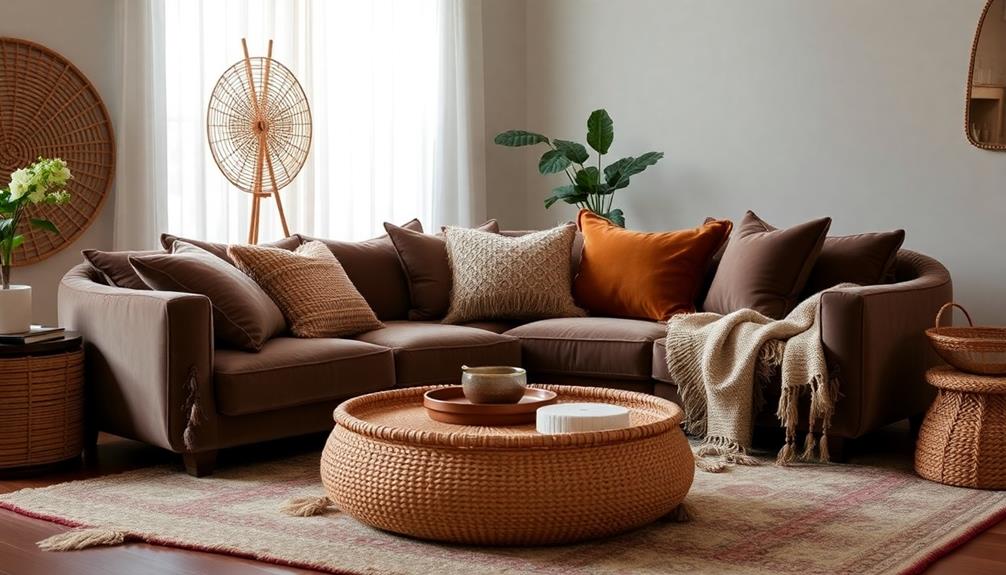
Incorporating a variety of textures and layers can transform a space, making it feel more inviting and dynamic. Start by using different textures like natural stone, distressed leather, and woven fabrics to create depth and visual interest. A jute rug can add warmth and comfort, enhancing the room's overall ambiance.
Emphasizing natural materials that resonate with Balinese design characteristics can further enrich your home's aesthetic.
Layering materials is essential; consider faux-vellum walls paired with soft textiles to create an intimate atmosphere that avoids monotony. Balance is key—mix hard surfaces with soft furnishings to maintain a harmonious environment. This not only guarantees comfort but also enhances aesthetic appeal.
Don't hesitate to experiment with layering. Combining plush cushions, woven throws, and sleek furniture will amplify the tactile experience of your home. This approach brings coziness and warmth, making your space feel lived-in and inviting.
Personalize Your Space

Transforming your home into a personal oasis starts with embracing plush fabrics and rich colors that evoke warmth and comfort. This is your chance to personalize your space, making it a true reflection of your individuality.
Consider adding unique pieces like Indonesian decor masks that represent rich cultural heritage, ensuring every decor choice resonates with your personality.
Use mood boards to visualize your style, ensuring every decor choice resonates with your personality.
Consider incorporating these elements into your design:
- Create your own art or showcase collections that express your passions.
- Mix high-end and low-end items for a curated look that feels authentic.
- Experiment with diverse styles and materials to add depth and interest.
- Focus on comfort by choosing inviting textiles and vibrant hues.
Your home should tell your story, so don't shy away from what makes you unique. By thoughtfully selecting pieces that resonate with you, you'll create an environment that feels both expressive and welcoming.
Optimize Lighting and Ambiance
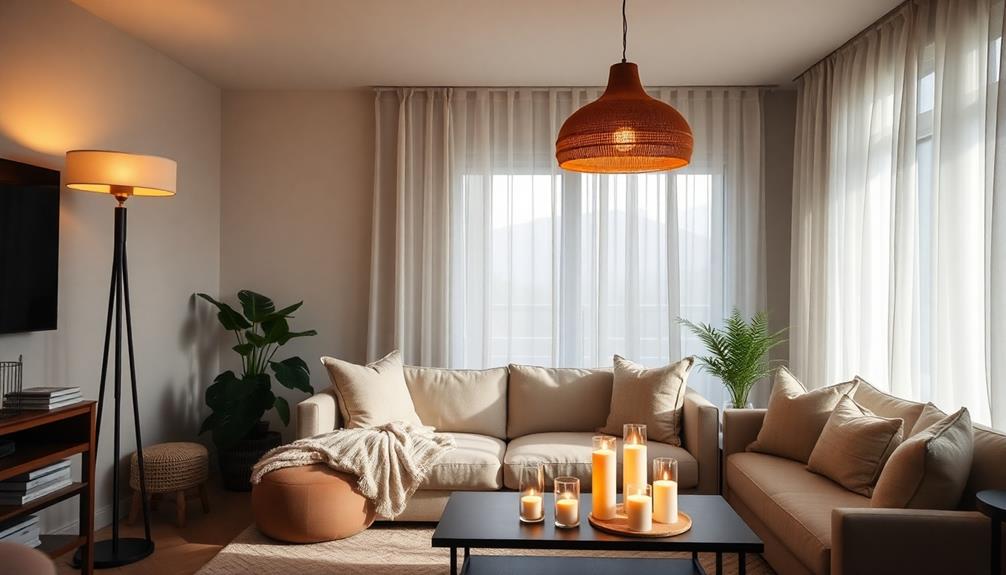
Creating the right lighting can dramatically enhance the ambiance of your home, making it feel warm and inviting. To achieve this, use a combination of task, ambient, and accent lighting. This layered lighting approach adds depth and dimension, making your space feel more dynamic and visually appealing.
Consider utilizing unique decor pieces from local artisans to complement your lighting choices. Opt for soft white bulbs in areas where you want a cozy atmosphere, while daylight bulbs work well in spaces that benefit from a more energizing vibe.
Consider incorporating smart lighting solutions for versatility. These allow you to adjust brightness and color temperature based on your activities or the time of day, enhancing the overall functionality of your space.
Strategically use lighting to highlight your home's design features, such as artwork or architectural details. This not only draws attention to focal points but also elevates your decor, creating a modern and stylish look.
Frequently Asked Questions
How to Decorate Your Home Like an Interior Designer?
To decorate your home like an interior designer, start by crafting a mood board. Select quality furniture, mix textures, layer lighting, and personalize spaces with unique accessories that reflect your style and experiences.
How to Style Like an Interior Designer?
Stylish selection's essential! Start with a mood board to map your vision. Mix materials for depth, balance heights, embrace negative space, and personalize with pieces that tell your story. Your unique style shines through!
How to Develop Your Own Interior Design Style?
To develop your own interior design style, reflect on your past experiences, identify your preferences, research various aesthetics, and experiment with mixing styles. Collaborate with designers to create a cohesive space that represents you authentically.
How to Decide Home Décor Style?
When deciding your home décor style, think about what resonates with you. Reflect on your likes, dislikes, and past experiences. Combine influences, explore online tools, and let your unique aesthetic shine through!
Conclusion
By following these steps, you'll transform your home into a stylish sanctuary that reflects your personality. Think of your space like a blank canvas; each choice adds color and depth to your masterpiece. Don't be afraid to experiment and let your creativity shine through! Remember, the key to great design lies in balance and harmony. Embrace your unique style, and soon you'll feel like an interior decor expert right in your own home.
Home Decor
How Feng Shui Can Help You Achieve the Perfect Home Energy Flow
Optimize your living space with Feng Shui principles to invite positive energy; discover how simple changes can transform your home into a sanctuary.
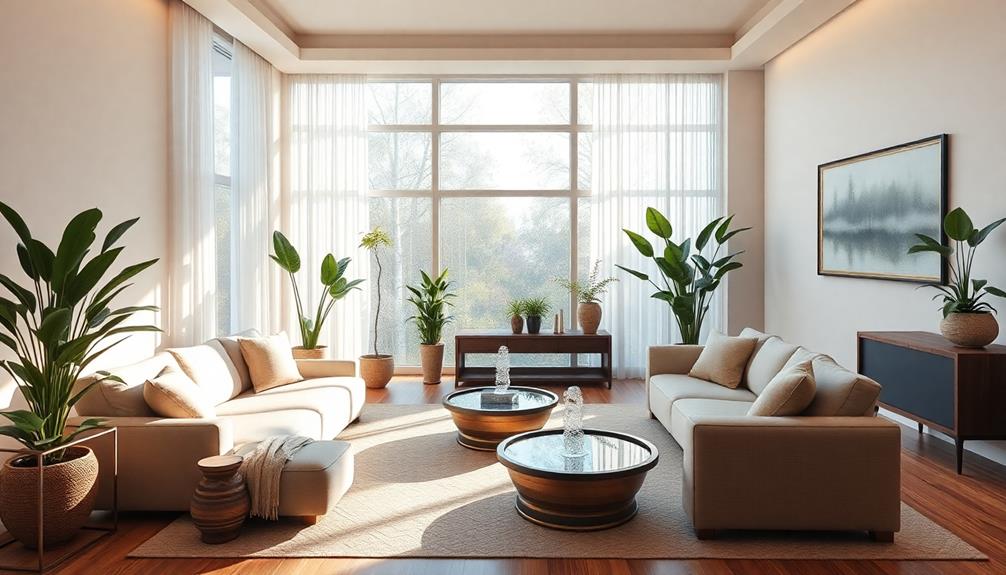
Feng Shui can help you achieve the perfect home energy flow by creating a harmonious space that invites positive chi. Start with mindful furniture placement; for instance, positioning your bed to see the door promotes security and comfort. Utilize the Bagua map to identify areas in your home that can enhance aspects like love or wealth. Declutter to clear any energetic blocks, and incorporate natural elements for tranquility. By balancing colors linked to the five elements, you'll enhance the overall atmosphere. Explore how to apply these principles effectively to transform your living space even further.
Key Takeaways
- Feng Shui enhances home energy flow by promoting harmonious chi movement through strategic furniture placement and decluttering.
- The Bagua map identifies areas of life to improve, aligning spaces with specific energies for wealth, love, and health.
- Incorporating the five elements and corresponding colors fosters balanced energy dynamics in each room.
- Regular assessments and adjustments maintain positive energy flow, adapting to seasonal changes and personal needs.
- Creating open pathways and using natural elements, like plants, enhances well-being and promotes a nurturing environment.
Overview of Feng Shui Principles
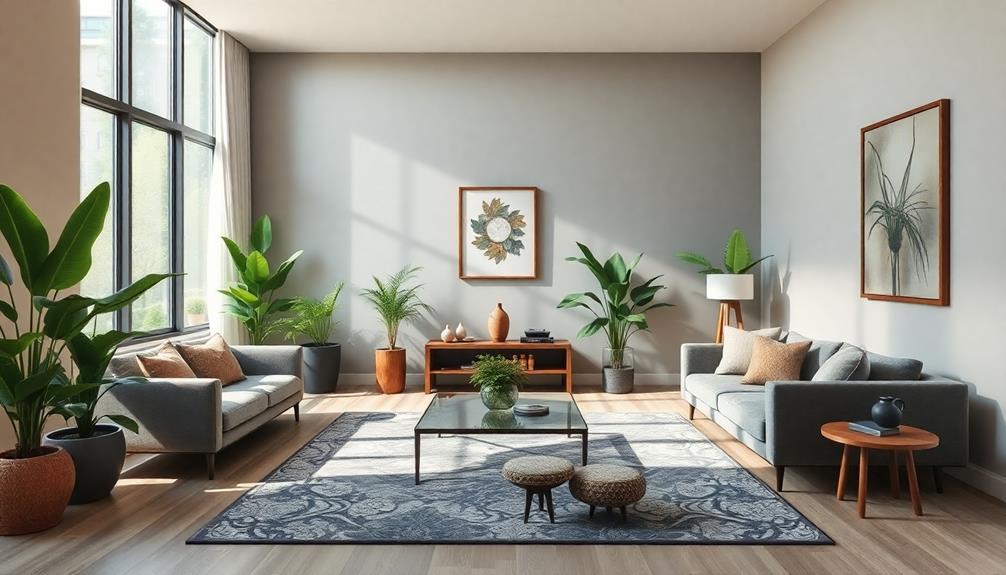
Feng Shui is all about creating a harmonious living space by enhancing the flow of chi energy. To achieve this, you'll want to understand some key Feng Shui principles that can transform your environment.
The five elements of Feng Shui—wood, fire, earth, metal, and water—each play a significant role in influencing energy flow. Incorporating elements like Indonesian decorative pillows can add vibrant colors and textures that enhance the overall ambiance. By incorporating these elements thoughtfully, you can establish balance and promote positive energy.
Another fundamental concept is Yin and Yang, representing the balance between passive and active energies. Striking this balance is essential for creating an inviting atmosphere. For example, a room with too much yang energy might feel chaotic, while an excess of yin could make it overly passive.
Arrangement of furniture is also important; it fosters movement and interaction, which enhances energy flow. Make sure your furniture doesn't block pathways but rather encourages free movement.
While the Bagua map is an important tool for identifying specific areas to enhance, the overarching principles of Feng Shui guide you in creating a space where chi can flow freely.
Understanding the Bagua Map
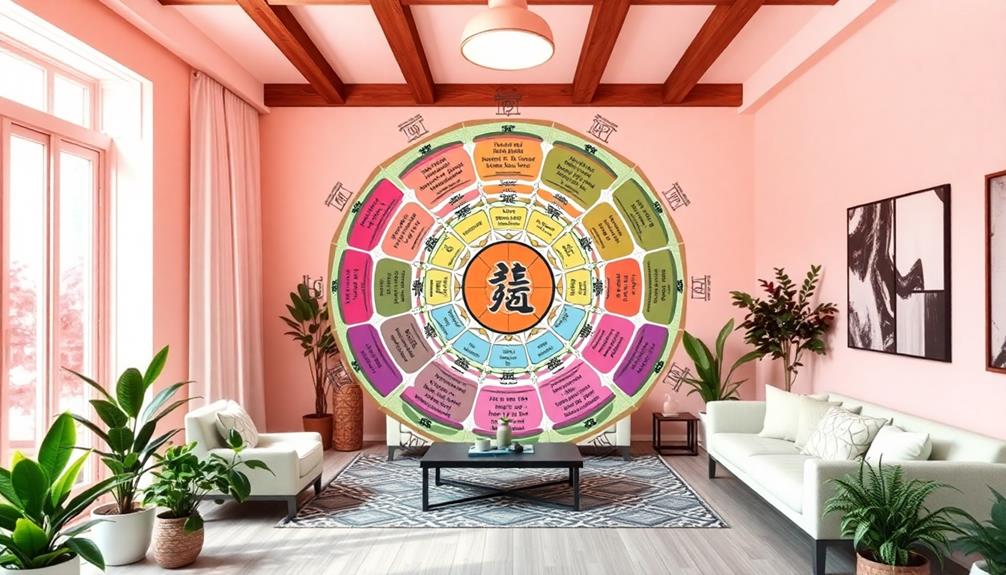
One powerful tool for enhancing your home's energy flow is the Bagua Map. This 8-sided diagram, often used by Feng Shui experts, helps you analyze and improve the energy in your space. You can also consider incorporating elements inspired by your culture, such as vibrant colors and traditional motifs, to create a unique ambiance in your home.
Here's how it works:
- Each area of the Bagua Map corresponds to specific life aspects like wealth, love, and family.
- The map aligns with your front door, the primary entry point for chi energy.
- Colors and elements linked to each area can enhance your space's energy.
To effectively use the Bagua Map, start by placing it over your home plan, ensuring the bottom edge aligns with your front door. Each section will reveal where you can make adjustments to improve various life aspects.
For instance, if you're looking to boost your wealth, focus on the area dedicated to prosperity and incorporate colors and decor that resonate with that energy. You might draw inspiration from Indonesian wedding decor ideas to bring a vibrant and cultural touch to your design.
You can apply the Bagua Map to individual rooms or your entire home, making it a versatile tool for enhancing your living environment.
Benefits of Feng Shui at Home

Harnessing the principles of Feng Shui can greatly enhance your home environment, leading to a multitude of benefits. By promoting a balanced energy flow, you can experience improved emotional well-being, increased feelings of safety, and comfort within your harmonious living space.
One of the core aspects of Feng Shui is decluttering, which opens up space for positive energy while reducing stressors that negatively impact your mood. Additionally, using the Bagua map allows you to focus on enhancing specific areas of your life, such as love or finances, through thoughtful placement of decor and furniture.
Here's a quick overview of the benefits you can enjoy:
| Benefit | Description |
|---|---|
| Emotional Well-being | Enhanced feelings of safety and comfort in your home. |
| Improved Relationships | Inviting spaces that foster better communication. |
| Increased Life Satisfaction | Decluttering leads to reduced stress and enhanced mood. |
| Personal Growth | Regular adjustments support ongoing positive energy flow. |
Embracing these Feng Shui principles can transform your home into a nurturing sanctuary, ultimately supporting your personal growth and well-being.
Practical Applications in Different Rooms
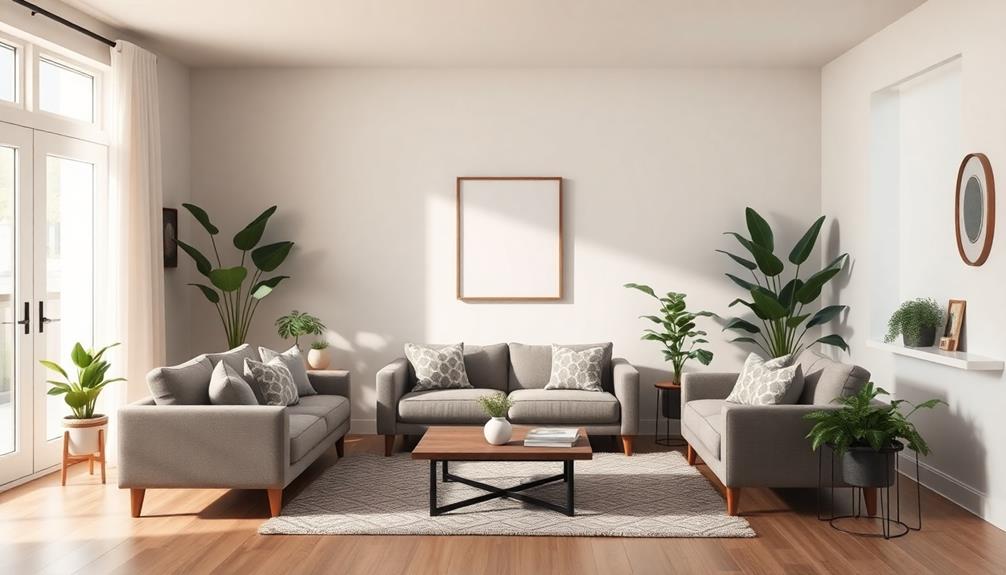
Often, small adjustments in each room can greatly enhance the energy flow in your home. By focusing on furniture placement and creating a commanding position in key areas, you can foster a more harmonious atmosphere.
Incorporating natural materials like wood and stone, reminiscent of Balinese design characteristics, can also contribute to a calming environment.
- Bedroom: Position your bed so you can see the door without being directly aligned with it, promoting security and restful energy.
- Living Room: Arrange furniture to face the entryway, allowing for easy movement and encouraging social interaction.
- Kitchen: Keep it decluttered by removing expired items and unnecessary appliances to nurture abundance and well-being.
In your home office, place your desk in a commanding position that gives you a clear view of the entrance. This setup enhances focus and productivity while making you feel in control.
For bathrooms, use calming colors and strategically place mirrors to redirect negative energy, creating a balanced atmosphere.
Techniques for Enhancing Energy Flow
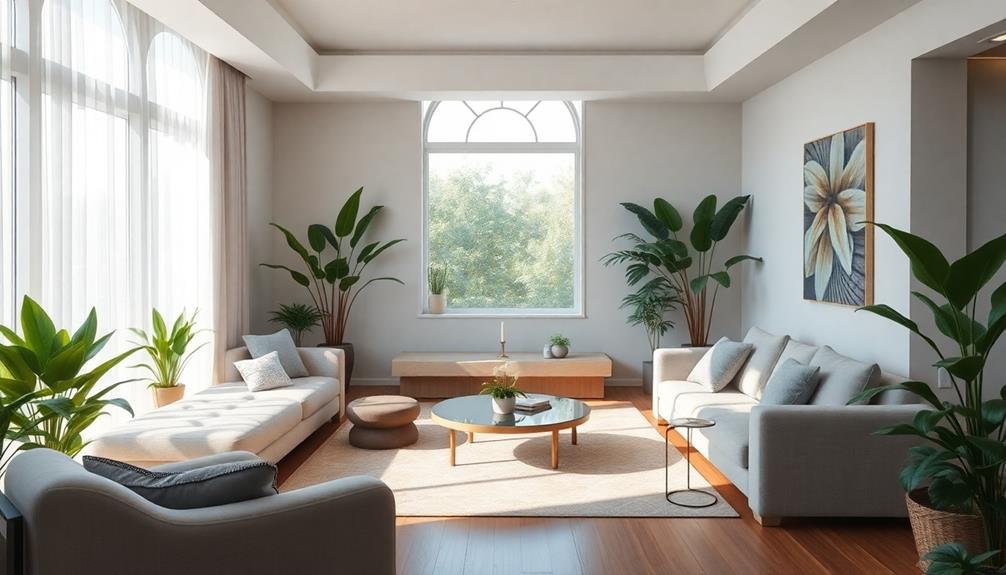
To enhance energy flow in your home, start by decluttering to clear out any blocks that hinder positive vibes.
Incorporating elements of traditional artistry such as Indonesian decor masks can add vibrant colors and unique designs that promote a sense of cultural harmony.
Next, consider your furniture placement; positioning items in the commanding position can foster a feeling of control and security.
Decluttering for Positive Energy
Decluttering transforms your space by removing energy blocks that hinder the flow of chi, the essential life force in Feng Shui. A clutter-free environment not only enhances the aesthetic of your home but also fosters positive energy.
Incorporating unique decorative elements, such as Indonesian decor masks, can further enrich your space by adding cultural significance and storytelling. Here are some effective techniques to help you declutter:
- Regularly assess your belongings and eliminate expired or unused items.
- Implement the "one in, one out" rule to maintain a consistent flow of positive energy.
- Organize with intention using functional and visually pleasing storage solutions.
By clearing visual clutter, especially in high-traffic areas like your kitchen and living room, you enhance mental clarity and emotional stability. This contributes to an overall sense of calm and well-being.
Remember, decluttering isn't just about tidying up; it's about creating space for new opportunities and positive experiences.
When you actively engage in decluttering, you're not just cleaning your home; you're inviting a revitalized chi flow that nurtures your spirit.
Embrace the process, and watch how your living environment transforms into a sanctuary of positive energy.
Strategic Furniture Placement
Creating a harmonious energy flow in your home goes beyond decluttering; it involves strategic furniture placement. Start by positioning larger furniture pieces, like your sofa and bed, in a commanding position where you can see the entrance. This arrangement promotes a sense of security and control in your space.
To enhance this concept, consider incorporating elements from luxury tropical designs that emphasize natural aesthetics and calming environments.
Next, be mindful of pathways. Avoid blocking walkways with furniture, as this can create stagnant energy. Open pathways encourage smooth energy flow and enhance the overall atmosphere of the room.
Incorporating natural elements, such as plants or wooden furniture, can ground your space and invite positive energy and tranquility.
Choose soft, soothing colors for your furniture to foster a calming environment that supports relaxation and emotional well-being.
Lastly, remember to regularly reassess your furniture placement. Seasonal changes or shifts in your personal needs may require adjustments to guarantee the energy flow remains vibrant and responsive.
Elemental Color Integration
Integrating elemental colors into your home can considerably enhance the energy flow, making spaces feel more vibrant and alive.
By understanding how colors correspond to the five elements in Feng Shui, you can create a harmonious atmosphere that resonates with your intentions.
Additionally, incorporating an open layout inspired by tropical villa plans can further promote a sense of spaciousness and tranquility.
Here are some techniques for effective elemental color integration:
- Choose colors based on the Bagua map: Use pinks in the love corner to boost romantic energy or greens in the family area for growth and harmony.
- Select colors for specific room atmospheres: Opt for calming blues in bedrooms to promote tranquility or bright yellows in kitchens for warmth.
- Incorporate colored decor strategically: Add metal tones in the west sector to support creativity and children's energy.
Addressing Limitations of Feng Shui

While Feng Shui can offer some benefits, its effectiveness really depends on your personal beliefs and perceptions.
Incorporating elements from traditional Indonesian housing may enhance the energy flow in your home, as these structures often reflect spiritual elements and cultural symbolism.
It's important to remember that it shouldn't be your only strategy for well-being; combining it with other approaches can lead to more thorough solutions.
Also, keep in mind that consulting a practitioner can be costly, which might limit access for some individuals.
Perception Variability
Although many people report positive changes from feng shui practices, the effectiveness of these methods can vary widely from person to person. This perception variability stems from several factors, primarily rooted in individual experiences and personal beliefs. For instance, the incorporation of natural materials in home decor, like those found in traditional Indonesian style home decor, can greatly influence how one perceives the energy flow within their space.
- The subjective nature of feng shui means benefits can differ considerably.
- Anecdotal evidence supports emotional well-being improvements, but scientific validation is limited.
- Interpretations of feng shui principles can lead to diverse applications and outcomes.
While feng shui serves as a useful tool for enhancing energy flow in your home, it shouldn't be viewed as a one-size-fits-all solution. What works for you may not resonate with someone else.
You might find that certain adjustments bring harmony and balance, while others see no change at all. This highlights the importance of personal exploration and adaptation in your feng shui journey.
Ultimately, your unique perception and belief system will shape how you experience feng shui's impact. Embrace the process, experiment with different techniques, and remember that the journey to achieving energy flow in your home is just as considerable as the results you hope to attain.
Need for Broader Strategies
Many homeowners find that relying solely on feng shui can fall short when it comes to addressing life's complexities. While feng shui consultants can help you enhance energy flow in your living space, they can't tackle deeper emotional or psychological issues that might require professional intervention.
Additionally, incorporating elements of modern tropical aesthetics can further enhance the energy flow by promoting a seamless connection between indoor and outdoor environments. It's vital to view feng shui as a complementary practice, not a standalone solution.
Personalized strategies are important, as the effectiveness of feng shui varies considerably from person to person. To truly create a harmonious environment, you should regularly reassess your space and incorporate broader strategies that address your unique life circumstances.
This might include stress management techniques, mindfulness practices, or even therapy.
Resources for Further Learning
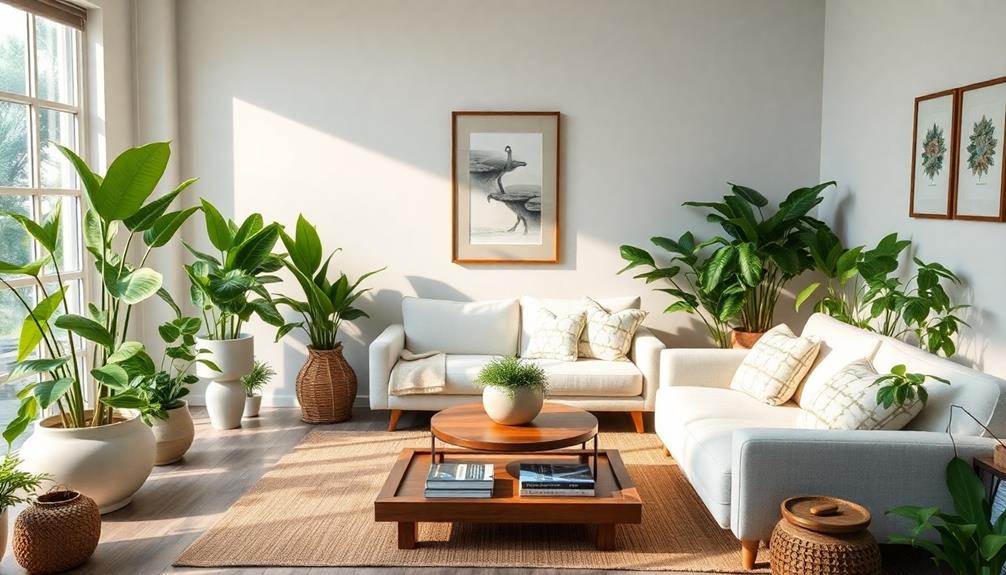
To deepen your understanding of Feng Shui and enhance your home's energy flow, you'll find a wealth of resources at your fingertips. These resources can help you improve the energy in your living space and create a harmonious environment. Here are a few suggestions to get you started:
- Books: Look for titles like *The Complete Illustrated Guide to Feng Shui* by Gavin Atkinson, which offers practical tips and in-depth knowledge.
- Online Platforms: Explore blogs and websites such as Feng Shui for Modern Living, where you'll find insights and case studies on applying Feng Shui principles.
- Community Engagement: Join forums or social media groups focused on Feng Shui. Engaging with fellow enthusiasts allows you to share experiences and solutions.
Additionally, consider attending workshops, webinars, and certification courses to further deepen your knowledge.
The International Feng Shui Guild is a valuable resource that provides articles, workshops, and a directory of certified practitioners to support your learning journey.
With these resources, you'll be well-equipped to transform your home and improve the energy flow effectively.
Frequently Asked Questions
How to Bring Positive Energy Into Your Home Feng Shui?
To bring positive energy into your home, start by decluttering and using the Bagua map. Incorporate the five elements, strategically place furniture, and regularly reassess your space to invite harmony and enhance your well-being.
How to Use Feng Shui in Your Home?
To use Feng Shui in your home, start by applying the Bagua map, decluttering spaces, arranging furniture for a commanding position, incorporating supportive colors, and regularly reassessing your environment to maintain positive energy flow.
What Is the Energy of Feng Shui?
The energy of Feng Shui, or chi, flows through your space, impacting your emotional and physical well-being. It balances Yin and Yang, utilizing the five elements to create a harmonious environment that supports your life.
How to Map Your Home for Feng Shui?
To map your home for Feng Shui, align the Bagua map with your front door. Assess each area's energy, using colors and elements specific to those corners, and adjust it regularly to match your evolving needs.
Conclusion
By embracing Feng Shui, you're not just rearranging your space; you're inviting harmony into your life. When you align your home's energy flow, you open doors to peace, productivity, and prosperity. So, why not take a step today? Transform your surroundings, and watch how your life transforms in return. Remember, a balanced home is a balanced mind—each corner tells a story, and every room holds potential. Let your environment reflect the energy you wish to cultivate.
Home Decor
Feng Shui Secrets Designers Swear By to Create a Calm and Harmonious Home
I uncover essential Feng Shui secrets that designers rely on to cultivate a peaceful home, but there’s so much more to discover for ultimate serenity.
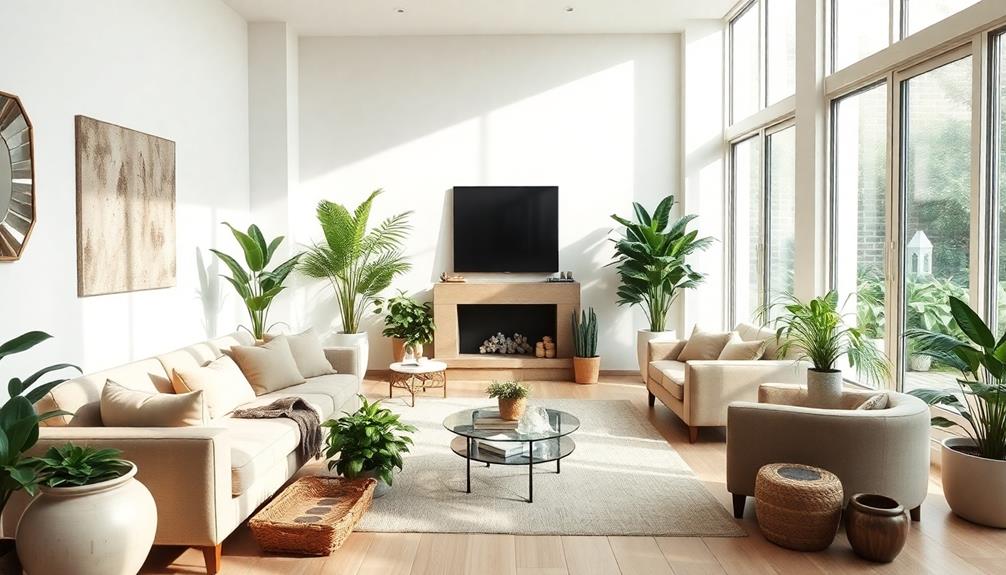
To create a calm and harmonious home, embrace Feng Shui principles that designers swear by. Start by using a Bagua map to identify energy flow in each area. Incorporate the five elements—Wood, Fire, Earth, Metal, Water—into your decor for balance. Prioritize soothing colors like green for family harmony and red for love. Avoid clutter to keep energy flowing freely and position furniture to enhance security and conversation. Use mirrors to amplify light and include natural elements, such as rounded-leaf plants. These strategies lay the foundation for a serene atmosphere, and you'll discover even more effective tips ahead.
Key Takeaways
- Utilize a Bagua map to identify specific areas of your home that correspond to different life aspects for targeted energy enhancement.
- Embrace soothing color palettes, like greens for family harmony and pinks for love, to create a calming environment.
- Position furniture in a command position, allowing for a clear view of the entrance, to promote security and positive energy flow.
- Maintain cleanliness and organization, especially in high-traffic areas, to prevent stagnation and enhance the flow of Chi.
- Introduce natural elements, such as rounded-leaf plants and mirrors, to amplify light and energy while fostering a nurturing atmosphere.
Understanding Feng Shui Principles
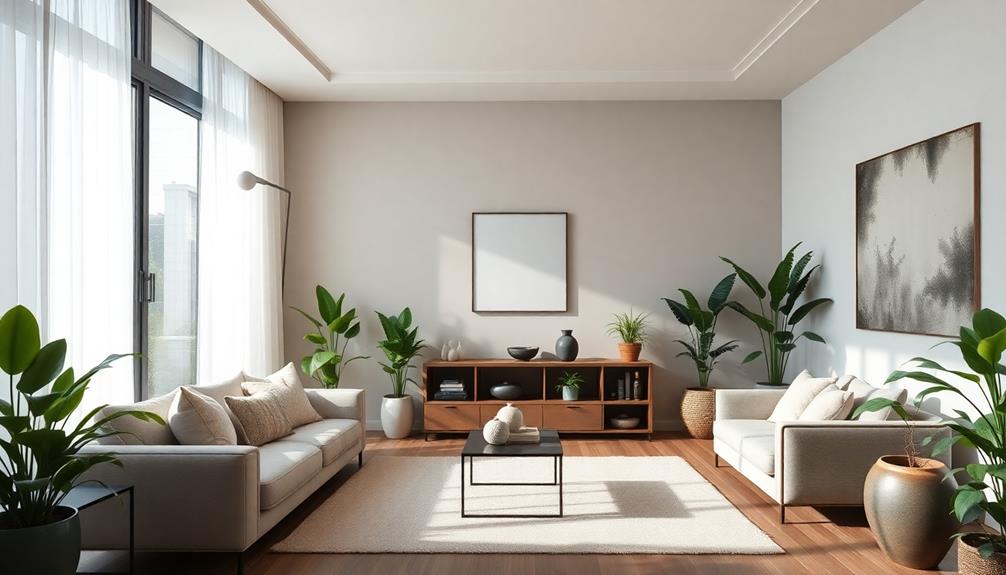
Understanding Feng Shui principles can transform your living space into a sanctuary of peace and balance. This ancient Chinese practice emphasizes the flow of energy, or Chi, in your environment. By making minor adjustments, you can create significant improvements in your quality of life.
Incorporating elements of Balinese design characteristics can enhance the natural flow of energy and create a harmonious atmosphere. The five elements of Feng Shui—Wood, Fire, Earth, Metal, and Water—are vital for achieving balance and harmony in your home. Each element links to specific colors and shapes that enhance positive energy.
Utilizing the Bagua map can guide your design decisions, as it divides your space into nine areas that correspond to different aspects of life, such as career and relationships.
Incorporating Yin and Yang concepts guarantees that opposing forces are harmonized, promoting well-being and tranquility. Proper furniture placement is essential; positioning key items in a commanding position and avoiding sharp corners facilitates a smooth energy flow.
Essential Feng Shui Tools
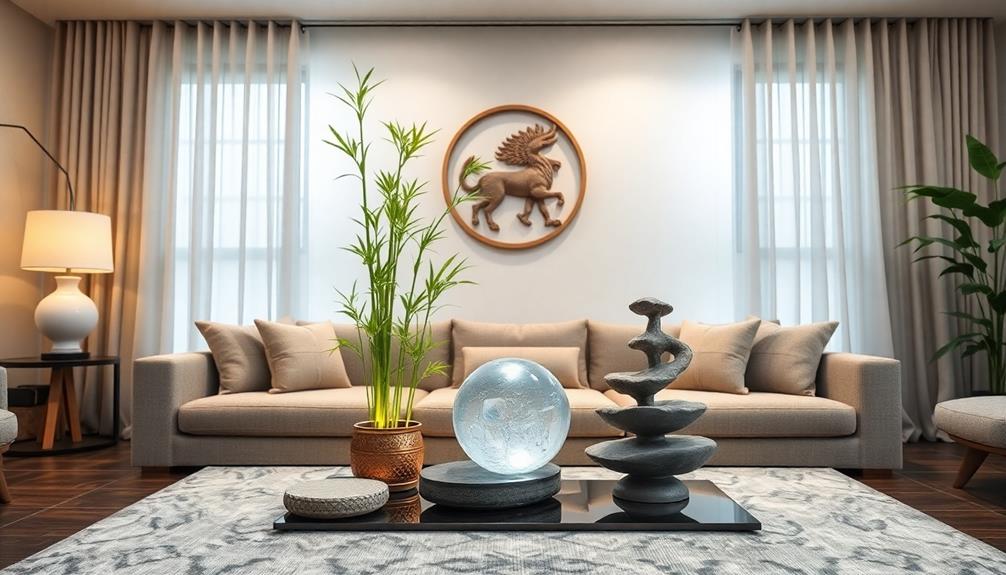
To create a harmonious environment, you'll want to utilize specific Feng Shui tools that enhance the flow of positive energy in your home. One of the most essential tools is the Bagua Map, which divides your space into nine areas, each reflecting different life aspects. Use this map to identify where to focus your energy improvements.
Incorporating Feng Shui Symbols like Buddha statues or wind chimes can greatly enhance positive energy flow and shield against negativity. Additionally, the Five Elements—Wood, Fire, Earth, Metal, and Water—should be included in your decor to balance the elements and support various life aspects.
Additionally, consider the color palette in your interior design ideas. Specific colors promote different energies, such as pink and red for love or green for finances.
Here's a quick reference table for your Feng Shui toolkit:
| Tool | Purpose |
|---|---|
| Bagua Map | Identify focus areas for energy flow |
| Feng Shui Symbols | Enhance positive energy and protection |
| Five Elements | Balance energies in decor |
| Color Palette | Promote desired outcomes |
Key Dos and Don'ts
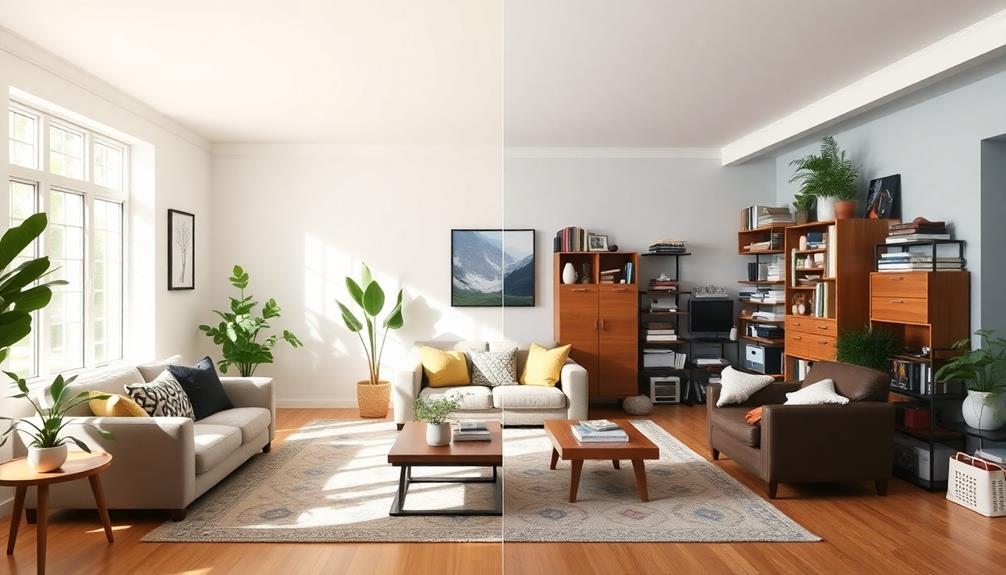
When it comes to creating a calm home with Feng Shui, following key Dos and Don'ts can make all the difference.
First, embrace Feng Shui tips by using soothing colors in your space. Opt for green to enhance family harmony and red to invite love, boosting positive energy throughout your home. Incorporating elements like Indonesian decorative pillows can add vibrant colors and intricate patterns that enhance the ambiance.
On the other hand, don't let clutter accumulate; it obstructs energy flow (Chi) and can lead to feelings of stagnation and stress.
Next, pay attention to furniture placement. Make sure your furniture is in a command position, ideally placed diagonally from the entrance. This setup fosters a sense of security and control.
Conversely, avoid sharp-edged furniture or decor, as they can create negative energy (Sha Qi) and discomfort in your environment.
Room-Specific Guidelines
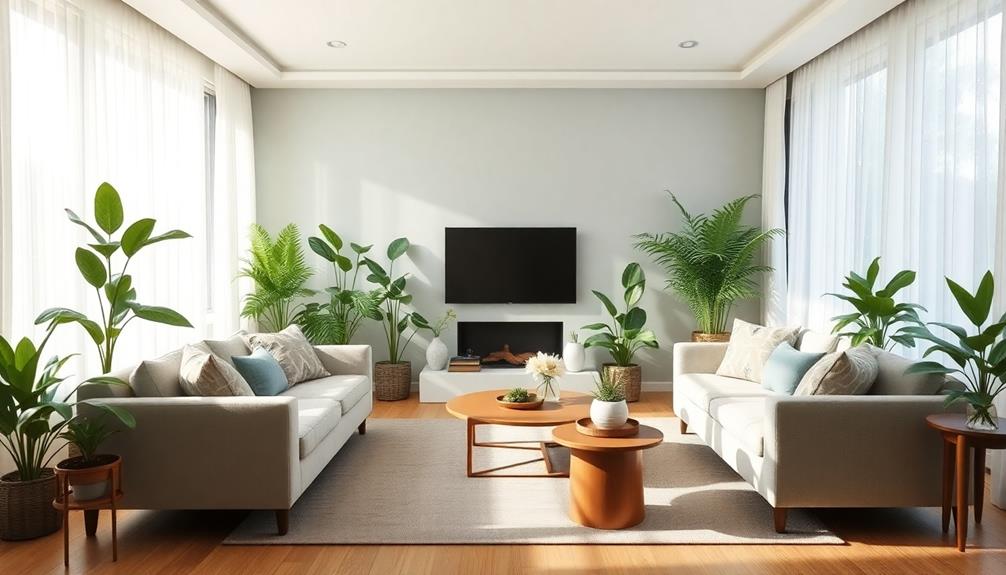
Creating a calm environment goes beyond general principles; it requires attention to each room's unique energy. For example, incorporating elements from luxury tropical designs can enhance the tranquility of your living space.
In your living room, position furniture to promote positive energy flow and encourage conversation. Soft lighting and comfortable seating create a peaceful and calming atmosphere, enhancing social interaction.
For the kitchen, keep the stove and sink clean and clutter-free. Ascertain your fridge is well-stocked and place the stove in a commanding position to optimize energy in your home.
In the bedroom, arrange your bed to have a clear view of the door, using calming colors like soft blues or greens. This creates balance and promotes restful sleep by minimizing distractions from electronics.
Maintain cleanliness in your bathroom, using soft lighting for a serene feel. Keep the toilet lid down and doors closed to preserve privacy and positive energy.
For your home office, position your desk to face the entrance, giving you a sense of control. Ascertain your workspace is organized and filled with natural light to enhance productivity and focus.
Incorporating small touches of color red can also invigorate your space, promoting smooth and uninterrupted energy flow.
Enhancing Energy Flow

Enhancing energy flow in your home is vital for fostering a calm and inviting atmosphere. To achieve this, it's important to create clear pathways, allowing Chi to circulate freely.
Regular decluttering is important; removing unnecessary items prevents stagnation and promotes positive energy to flow throughout your space. Incorporating elements of modern tropical aesthetics in Bali can further enhance this flow, as they emphasize natural materials and open layouts that invite light and air.
Consider the flow of your furniture. Positioning it diagonally from the entrance creates a commanding view, giving you a sense of control and security. This simple adjustment can greatly enhance the overall energy dynamics of your room.
Incorporating mirrors is another effective way to amplify light and energy, especially in darker areas. They not only brighten spaces but also create a visual expansion, making the environment feel more open and harmonious.
Lastly, introduce natural elements like plants with rounded leaves to invigorate your space, promoting a nurturing vibe.
These small changes contribute to creating balance and harmony in your home. By focusing on these strategies, you'll cultivate an environment where energy that flows effortlessly supports your well-being and tranquility.
Frequently Asked Questions
How to Bring Peace at Home Feng Shui?
To bring peace at home, clear clutter to enhance energy flow, position furniture for security, use soothing colors, incorporate warm lighting, and add natural elements like plants to foster a calming atmosphere.
What Is Bad Feng Shui for a House?
Beware of bad feng shui! If your entrance faces a staircase, sharp corners threaten comfort, clutter clogs chi, dark areas dampen mood, and broken items breed stagnation. Tidy up to transform your space!
What Are the Feng Shui Rules for a House?
To create positive energy in your house, follow basic Feng Shui rules. Position your entrance welcomingly, declutter spaces, arrange furniture for comfort and visibility, and incorporate natural elements like plants to enhance harmony and flow.
How to Make a House Lucky Feng Shui?
To make your house lucky, position your entrance for clear views, incorporate the five elements in your decor, keep spaces clutter-free, use mirrors for light, and enhance areas linked to wealth and health.
Conclusion
Just like a well-tended garden thrives, your home flourishes when you embrace Feng Shui principles. By nurturing the energy flow and respecting the essential tools, you transform your space into a tranquil oasis. Remember, a calm home reflects a calm mind, much like a still pond mirrors the sky. So, as you rearrange and refine your surroundings, envision your home as a sanctuary where peace blossoms, inviting harmony into every corner of your life.
Home Decor
The Feng Shui Furniture Rule That Will Instantly Improve Your Space
Get ready to transform your space with the Feng Shui furniture rule that promotes harmony and flow—discover how to elevate your environment today!
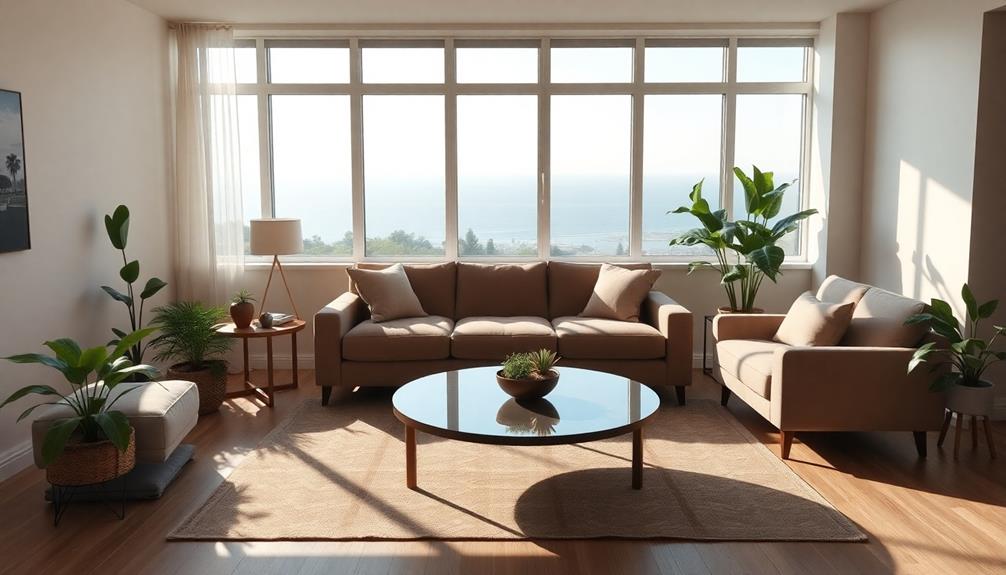
To instantly improve your space, position your furniture in the command position. This means placing key pieces like your bed or desk in a way that you can see the entrance while feeling supported by a solid wall behind you. Avoid pushing furniture against windows or corners to keep energy flowing. Make sure pathways are clear for easy movement. Adding natural elements, like plants, enhances this flow further. With a few tweaks, you can create a harmonious and inviting atmosphere. If you want to explore more ways to elevate your space, there's much more to discover!
Key Takeaways
- Position beds and desks in the command position to enhance energy flow and visibility of entrances for greater comfort and relaxation.
- Clear pathways and avoid clutter to facilitate movement, preventing energy stagnation and promoting tranquility within your space.
- Incorporate natural elements like plants to ground energy and refresh the atmosphere, enhancing vitality in your environment.
- Use soothing colors that resonate with you to influence mood and create a calming ambiance throughout your living space.
- Regularly reassess and update your furniture arrangement to align with personal growth, seasonal changes, and evolving preferences.
Understanding the Command Position

When you understand the command position, you can considerably enhance the flow of energy in your home. The command position refers to the strategic placement of furniture, particularly your bed and desk, allowing you to see the entrance while maintaining distance from direct sightlines. Incorporating elements like Indonesian decorative pillows can further enhance your space with their vibrant colors and intricate patterns, promoting a warm and inviting atmosphere. This setup fosters a sense of security and control, promoting relaxation.
In the bedroom, position your bed against a solid wall, ensuring you have visibility of the door while keeping pathways clear for ideal energy flow. This arrangement not only creates a peaceful sanctuary but also enhances your overall well-being.
In your living room, placing seating in a command position encourages conversation and interaction, enhancing the overall social atmosphere. Similarly, in your home office, position your desk to face the entrance, empowering you to feel aware of your surroundings while you work.
Avoid placing furniture against windows or crammed into corners, as this can disrupt energy flow and create feelings of vulnerability.
Balancing Energy Flow

Mastering the command position sets the foundation for a harmonious living space, but balancing energy flow takes it a step further. To truly enhance your environment, focus on furniture arrangements that create clear pathways and avoid clutter. This allows energy to circulate freely and prevents stagnation.
Consider the following elements to improve your space:
| Element | Importance |
|---|---|
| Clear Pathways | Promote movement and prevent obstruction. |
| Natural Elements | Incorporate plants for grounding energy. |
| Soothing Colors | Use soft tones to enhance tranquility. |
| Visibility of Front Door | Foster comfort and reduce anxiety. |
Position larger furniture pieces to encourage interaction while ensuring visibility of entrances. This not only nurtures a sense of security but also supports social connections. Regularly reassess your furniture arrangement and embrace seasonal decor changes to maintain ideal energy flow. By doing so, you'll create a clutter-free environment that radiates balance and tranquility, transforming your space into a calming sanctuary. Prioritizing these aspects of Feng Shui will elevate your living experience and promote a serene atmosphere for you and your guests. Incorporating feng shui furniture ideas can also inspire creative layouts that maximize both functionality and harmony within your space. Consider using round tables to encourage equality in conversations or placing mirrors strategically to reflect natural light and amplify positive energy. These thoughtful adjustments will further align your home with Feng Shui principles, enhancing its overall warmth and inviting ambiance.
Optimal Furniture Placement
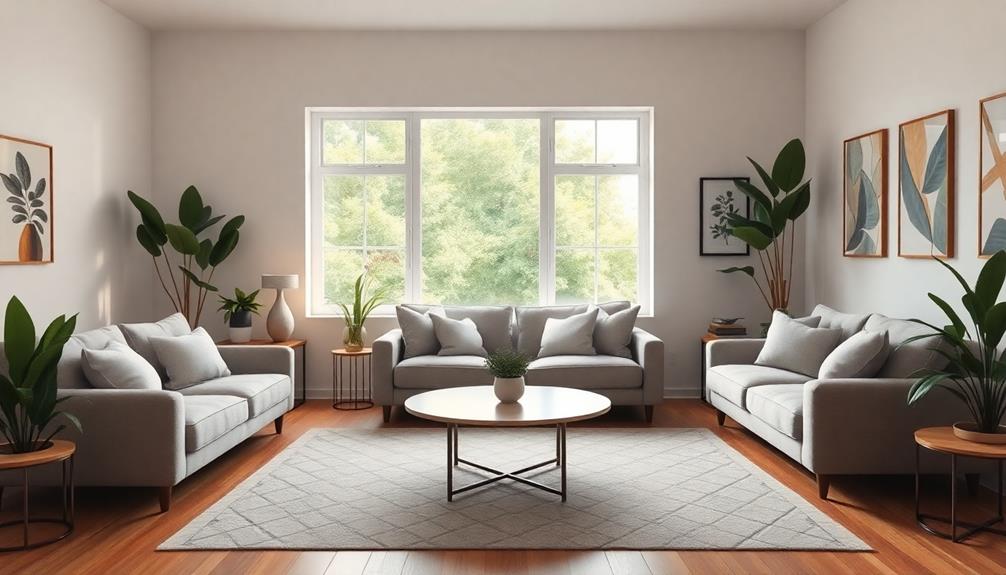
Optimal furniture placement is vital for creating a harmonious living space that promotes positive energy flow. To achieve ideal furniture placement, position larger pieces, like sofas, away from walls. This setup encourages an inviting atmosphere and facilitates conversation while ensuring you can see the front door for a sense of security.
Incorporating elements from Balinese design characteristics can further enhance the energy of your space by blending traditional craftsmanship with modern aesthetics. Avoid placing the back of the sofa against a window, as this blocks energy flow and may lead to feelings of instability.
Arrange seating to promote easy movement and interaction, keeping pathways clear to enhance overall energy. Incorporating natural elements, such as plants, can ground your space and elevate the energy. Place these near natural light sources for ideal growth, as they contribute to a vibrant environment.
Regular reassessments of your furniture arrangement are essential. By making seasonal adjustments, you can refresh your space, ensuring it continues to support your emotional well-being.
Always be open to tweaking your layout; sometimes, a simple shift can greatly enhance positive energy flow and create a more inviting atmosphere. Embrace these strategies to cultivate a space that nurtures both you and your guests.
Personalizing Your Space
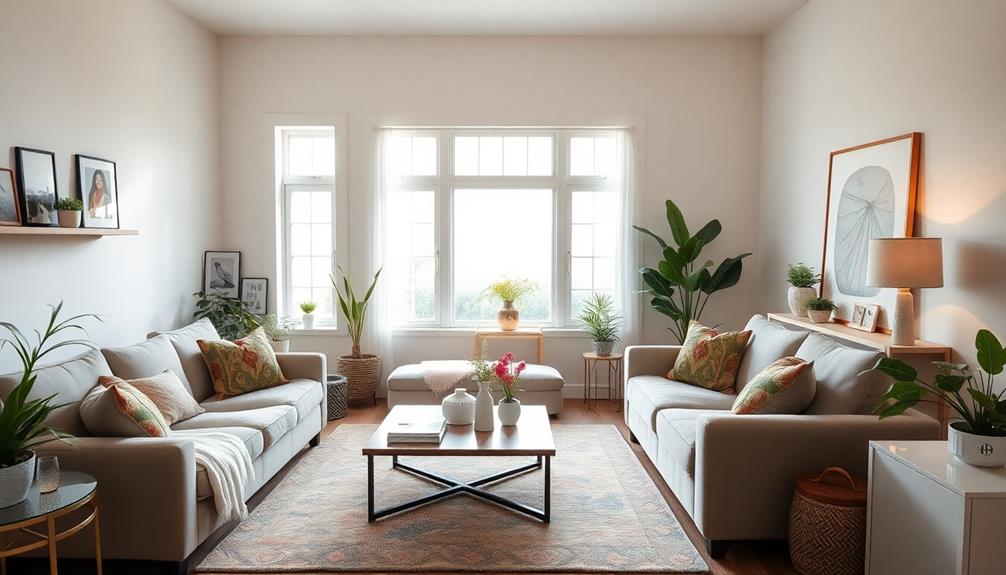
Personalizing your space transforms it into a reflection of who you are, making it feel more like home. Start by incorporating sentimental items like family photos or meaningful artwork, such as a unique Indonesian decor mask that represents rich cultural heritage. These pieces enhance your emotional connection to the space, fostering a sense of belonging.
Choose colors that resonate with you; they can greatly influence your mood and energy levels, promoting a calming atmosphere.
Don't forget to bring in natural elements such as plants and wood materials. These additions ground your space and provide a revitalizing connection to nature.
Regularly reassessing your decor allows you to reflect seasonal changes or personal growth, maintaining ideal energy flow and liveliness in your living area.
Thoughtful placement is key. Grouping objects in odd numbers can create visual appeal and elevate the overall harmony of the room.
Maintaining Harmony Over Time

Maintaining harmony in your space is essential for fostering a positive and inviting atmosphere. To guarantee your environment promotes ideal energy flow, regularly reassess your furniture arrangement. Seasonal changes often call for adjustments, so keep your space feeling fresh and welcoming.
| Action | Purpose |
|---|---|
| Declutter | Prevent stagnant energy |
| Incorporate | Utilize natural elements |
| Personal items | Evoke positive emotions |
| Schedule updates | Keep energy dynamic |
| Refresh energy | Create a calming atmosphere |
By decluttering consistently, you'll prevent stagnant energy, allowing tranquility to flourish. Incorporating natural elements like plants can further refresh energy, creating a calming atmosphere that nurtures your well-being. Don't forget to include personal items that evoke positive emotions, enhancing the overall harmony of your space.
Lastly, schedule periodic updates to your decor and furniture placement. This keeps your living space aligned with your evolving preferences and lifestyle. Embrace these practices to maintain harmony over time, guaranteeing your home remains a sanctuary that supports your journey to well-being.
Frequently Asked Questions
How to Feng Shui Your Space?
To feng shui your space, arrange furniture for clear pathways, promote conversation with seating, incorporate natural elements, use calming colors, declutter regularly, and strategically place mirrors to enhance light and energy flow.
How to Place Furniture According to Feng Shui?
Placing furniture's like arranging a dance; you want partners to face each other. Position your seating to encourage conversation, clear pathways for movement, and always guarantee a view of the door for security and comfort.
How Can I Improve My Room Feng Shui?
To improve your room's feng shui, position your bed for visibility of the door, declutter pathways, use soothing colors, add plants, and regularly reassess your arrangement for ideal energy flow and tranquility.
How Do You Arrange Furniture for Positive Energy?
To arrange furniture for positive energy, create clear pathways, position seating to face the door, encourage conversation with your layout, and incorporate natural elements. Regularly refresh arrangements to maintain an uplifting atmosphere in your space.
Conclusion
By following these feng shui principles, you can transform your space into a sanctuary that feels both inviting and balanced. Remember, it's all about creating harmony and flow. Have you considered how your furniture placement affects your daily energy? With a little mindfulness and personalization, you'll not only enhance your surroundings but also elevate your mood. Keep reassessing and adjusting as needed to maintain that perfect balance and guarantee your space continues to inspire you.
-

 Mom5 months ago
Mom5 months agoHeartfelt Poems for Your Daughter’s Birthday
-

 Mom5 months ago
Mom5 months agoHappy Birthday Religious Wishes and Blessings
-

 Mom5 months ago
Mom5 months agoHappy 65th Birthday: Celebrate Your Special Day!
-

 Mom5 months ago
Mom5 months agoHappy Birthday in Heaven from Daughter: Remembering You
-

 Mom5 months ago
Mom5 months ago62nd Birthday Quotes for Mom: Celebrate Her Special Day
-

 Mom5 months ago
Mom5 months agoCelebrating 60 Years: Happy 60th Birthday Wishes
-

 Special Occasions4 months ago
Special Occasions4 months agoUplifting Words: Inspirational Church Anniversary Messages!
-

 Mom5 months ago
Mom5 months agoCelebrate a Joyous Happy 70th Birthday Milestone!

















